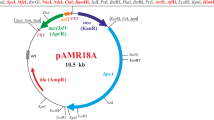Abstract
A simple method to introduce marker-free deletions, insertions, and point mutations into the chromosomes of naturally nontransformable Bacillus amyloliquefaciens strains has been developed. The method is efficient and fast, and it allows for the generation of genetic modifications without the use of a counter-selectable marker or a special prerequisite strain. This method uses the combination of the following: the effective introduction of a delivery plasmid into cells for gene replacement; a two-step replacement recombination procedure, which occurs at a very high frequency due to the use of a thermosensitive rolling-circle replication plasmid; and colony polymerase chain reaction (PCR) analysis for screening. Using PCR primers with mismatches at the 3′ end enables the selection of strains that contain a single nucleotide substitution in the target gene. This approach can be used as a routine method for the investigation of complex physiological pathways and for the metabolic engineering of food-grade industrial B. amyloliquefaciens and other Bacillus strains.




Similar content being viewed by others
References
Anagnostopoulos C, Spizizen J (1961) Requirements for transformation in Bacillus subtilis. J Bacteriol 81:741–746
Arnaud M, Chastanet A, Débarbouillé M (2004) New vector for efficient allelic replacement in naturally nontransformable, low-GC-content, gram-positive bacteria. Appl Environ Microbiol 70:6887–6891
Bhowmik T, Fernández L, Steele JL (1993) Gene replacement in Lactobacillus helveticus. J Bacteriol 175:6341–6344
Biswas I, Gruss A, Ehrlich SD, Maguin E (1993) High-efficiency gene inactivation and replacement system for gram-positive bacteria. J Bacteriol 175:3628–3635
Bloor AE, Cranenburgh RM (2006) An efficient method of selectable marker gene excision by Xer recombination for gene replacement in bacterial chromosomes. Appl Environ Microbiol 72:2520–2525
Brans A, Filée P, Chevigné A, Claessens A, Joris B (2004) New integrative method to generate Bacillus subtilis recombinant strains free of selection markers. Appl Environ Microbiol 70:7241–7250
Chen XH, Koumoutsi A, Scholz R, Eisenreich A, Schneider K, Heinemeyer I, Morgenstern B, Voss B, Hess WR, Reva O, Junge H, Voigt B, Jungblut PR, Vater J, Süssmuth R, Liesegang H, Strittmatter A, Gottschalk G, Borriss R (2007) Comparative analysis of the complete genome sequence of the plant growth promoting Bacillus amyloliquefaciens FZB42. Nat Biotechnol 25:1007–1014
Coukoulis H, Campbell LL (1971) Transformation in Bacillus amyloliquefaciens. J Bacteriol 105:319–322
Fabret C, Ehrlich SD, Noirot P (2002) A new mutation delivery system for genome-scale approaches in Bacillus subtilis. Mol Microbiol 46:25–36
Huang MM, Arnheim N, Goodman MF (1992) Extension of base mispairs by Taq DNA polymerase: implications for single nucleotide discrimination in PCR. Nucleic Acids Res 20:4567–4573
Janes BK, Stibitz S (2006) Routine markerless gene replacement in Bacillus anthracis. Infect Immun 74:1949–1953
Jomantas JAV, Fiodorova JA, Abalakina EG, Kozlov YI (1991) Genetics of Bacillus amyloliquefaciens. 6th International Conference on Bacilli, Stanford, Calif., abstr. no T7
Liu S, Endo K, Ara K, Ozaki K, Ogasawara N (2008) Introduction of marker-free deletions in Bacillus subtilis using the AraR repressor and the ara promoter. Microbiology 154:2562–2570
Maguin E, Prevost H, Ehrlich SD, Gruss A (1996) Efficient insertional mutagenesis in lactococci and other Gram-positive bacteria. J Bacteriol 178:931–935
Mandal M, Breaker RR (2004) Adenine riboswitches and gene activation by disruption of a transcription terminator. Nat Struct Mol Biol 11:29–35
Miller JH (1972) Experiments in molecular genetics. Cold Spring Harbor Laboratory, New York
Noirot P, Petit MA, Ehrlich SD (1987) Plasmid replication stimulates DNA recombination in Bacillus subtilis. J Mol Biol 196:39–48
Nygaard P, Saxild HH (2005) The purine efflux pump PbuE in Bacillus subtilis modulates expression of the PurR and G-box (XptR) regulons by adjusting the purine base pool size. J Bacteriol 187:791–794
Ramaley RF, Vasantha N (1983) Glycerol protection and purification of Bacillus subtilis glucose dehydrogenase. J Biol Chem 258:12558–12565
Razer PN, Moran CP Jr (1988) Compartment-specific transcription in Bacillus subtilis: identification of the promoter for gdh. J Bacteriol 170:5086–5092
Sambrook J, Russell DW (2001) Molecular cloning: laboratory manual, 3rd edn. Cold Spring Harbor Laboratory, Cold Spring Harbor
Shatalin KY, Neyfakh AA (2005) Efficient gene inactivation in Bacillus anthracis. FEMS Microbiol Lett 15:315–319
Sommer SS, Cassady JD, Sobell JL, Bottema CD (1989) A novel method for detecting point mutations or polymorphisms and its application to population screening for carriers of phenylketonuria. Mayo Clin Proc 64:1361–1372
Vehmaanperä J (1988) Transformation of Bacillus amyloliquefaciens protoplasts with plasmid DNA. FEMS Microbiol Lett 49:101–105
Vehmaanperä J (1989) Transformation of Bacillus amyloliquefaciens by electroporation. FEMS Microbiol Lett 52:165–169
Vehmaanperä J, Steinborn G, Hofemeister J (1991) Genetic manipulation of Bacillus amyloliquefaciens. J Biotechnol 19:221–240
Waschkau B, Waldeck J, Wieland S, Eichstädt R, Meinhardt F (2008) Generation of readily transformable Bacillus licheniformis mutants. Appl Microbiol Biotechnol 78:181–188
Wu DY, Ugozzoli L, Pal BK, Wallace RB (1989) Allele-specific enzymatic amplification of β-globin genomic DNA for diagnosis of sickle cell anemia. Proc Natl Acad Sci U S A 86:2757–2760
Yan X, Yu HJ, Hong Q, Li SP (2008) Cre/lox system and PCR-based genome engineering in Bacillus subtilis. Appl Environ Microbiol 74:5556–5562
Zakataeva NP, Gronskiy SV, Sheremet AS, Kutukova EA, Novikova AE, Livshits VA (2007) A new function for the Bacillus PbuE purine base efflux pump: efflux of purine nucleosides. Res Microbiol 158:659–665
Zhang XZ, Yan X, Cui ZL, Hong Q, Li SP (2006) mazF, a novel counter-selectable marker for unmarked chromosomal manipulation in Bacillus subtilis. Nucleic Acids Res 34:e71
Acknowledgments
We are very grateful to J. Jomantas for the gift of the E40 bacteriophage and for his help with its use. We would also like to thank A. S. Mironov for providing the pKS1 plasmid and K. Matsuno for a critical reading of the manuscript.
Author information
Authors and Affiliations
Corresponding author
Rights and permissions
About this article
Cite this article
Zakataeva, N.P., Nikitina, O.V., Gronskiy, S.V. et al. A simple method to introduce marker-free genetic modifications into the chromosome of naturally nontransformable Bacillus amyloliquefaciens strains. Appl Microbiol Biotechnol 85, 1201–1209 (2010). https://doi.org/10.1007/s00253-009-2276-1
Received:
Revised:
Accepted:
Published:
Issue Date:
DOI: https://doi.org/10.1007/s00253-009-2276-1




